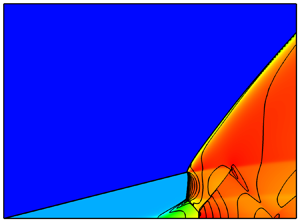Crossref Citations
This article has been cited by the following publications. This list is generated based on data provided by
Crossref.
Wang, Aifeng
Shang, Jiahao
Wang, Qiu
and
Wang, Kuanliang
2021.
Effects of Cowl-Induced Expansion on the Wave Complex Induced by Oblique Detonation Wave Reflection.
Processes,
Vol. 9,
Issue. 7,
p.
1215.
Guo, Hongbo
Yang, Honglei
Zhao, Ningbo
Li, Shuying
and
Zheng, Hongtao
2021.
Influence of incoming flow velocity and mixture equivalence ratio on oblique detonation characteristics.
Aerospace Science and Technology,
Vol. 119,
Issue. ,
p.
107088.
Guo, Hongbo
Zhao, Ningbo
Yang, Honglei
Li, Shuying
and
Zheng, Hongtao
2021.
Analysis on stationary window of oblique detonation wave in methane-air mixture.
Aerospace Science and Technology,
Vol. 118,
Issue. ,
p.
107038.
Teng, Honghui
Ng, Hoi Dick
Yang, Pengfei
and
Wang, Kuanliang
2021.
Near-field relaxation subsequent to the onset of oblique detonations with a two-step kinetic model.
Physics of Fluids,
Vol. 33,
Issue. 9,
Shi, Xinxing
Xie, Haopin
Zhou, Lin
and
Zhang, Yining
2022.
A theoretical criterion on the initiation type of oblique detonation waves.
Acta Astronautica,
Vol. 190,
Issue. ,
p.
342.
TENG, Honghui
ZHANG, Yuhang
YANG, Pengfei
and
JIANG, Zonglin
2022.
Oblique detonation wave triggered by a double wedge in hypersonic flow.
Chinese Journal of Aeronautics,
Vol. 35,
Issue. 4,
p.
176.
Yang, Li
Yue, Lianjie
Yu, Dehai
and
Chen, Zheng
2022.
Numerical study on wave configuration of wedge-induced oblique detonation wave: Reactive boundary layer effect.
Physics of Fluids,
Vol. 34,
Issue. 11,
Yao, Kepeng
Wang, Chun
and
Jiang, Zonglin
2022.
A numerical study of oblique detonation re-stabilization by expansion waves.
Aerospace Science and Technology,
Vol. 122,
Issue. ,
p.
107409.
Wang, Aifeng
Bian, Jing
and
Teng, Honghui
2022.
Numerical study on initiation of oblique detonation wave by hot jet.
Applied Thermal Engineering,
Vol. 213,
Issue. ,
p.
118679.
Zhang, Zijian
Liu, Yunfeng
and
Wen, Chihyung
2022.
Mechanisms of the destabilized Mach reflection of inviscid oblique detonation waves before an expansion corner.
Journal of Fluid Mechanics,
Vol. 940,
Issue. ,
Guo, Hongbo
Xu, Yong
Li, Shuying
and
Zhang, Huangwei
2022.
On the evolutions of induction zone structure in wedge-stabilized oblique detonation with water mist flows.
Combustion and Flame,
Vol. 241,
Issue. ,
p.
112122.
Zhang, Zijian
Wen, Chihyung
Yuan, Chaokai
Liu, Yunfeng
Han, Guilai
Wang, Chun
and
Jiang, Zonglin
2022.
An experimental study of formation of stabilized oblique detonation waves in a combustor.
Combustion and Flame,
Vol. 237,
Issue. ,
p.
111868.
Sun, Jie
Yang, Pengfei
Tian, Baolin
and
Chen, Zheng
2022.
Effects of wedge-angle change on the evolution of oblique detonation wave structure.
Physics of Fluids,
Vol. 34,
Issue. 9,
Salehi, Fatemeh
Abbassi, Rouzbeh
Asadnia, Mohsen
Chan, Billy
and
Chen, Longfei
2022.
Overview of safety practices in sustainable hydrogen economy – An Australian perspective.
International Journal of Hydrogen Energy,
Vol. 47,
Issue. 81,
p.
34689.
Wang, Jiabao
Zhao, Xinyu
Fan, Liangyi
Pan, Jianfeng
and
Zhu, Yuejin
2023.
Effects of the quantity and arrangement of reactive jet obstacles on flame acceleration and transition to detonation: A numerical study.
Aerospace Science and Technology,
Vol. 137,
Issue. ,
p.
108269.
Desai, Swapnil
Tao, Yujie
Sivaramakrishnan, Raghu
and
Chen, Jacqueline H.
2023.
Effects of non-thermal termolecular reactions on wedge-induced oblique detonation waves.
Combustion and Flame,
Vol. 257,
Issue. ,
p.
112681.
Sun, Jie
Wang, Yiqing
Tian, Baolin
and
Chen, Zheng
2023.
detonationFoam: An open-source solver for simulation of gaseous detonation based on OpenFOAM.
Computer Physics Communications,
Vol. 292,
Issue. ,
p.
108859.
Guo, Hongbo
Xu, Yong
Zheng, Hongtao
and
Zhang, Huangwei
2023.
Ignition limit and shock-to-detonation transition mode of n-heptane/air mixture in high-speed wedge flows.
Proceedings of the Combustion Institute,
Vol. 39,
Issue. 4,
p.
4771.
Majewski, Peter
Salehi, Fatemeh
and
Xing, Ke
2023.
Green hydrogen.
AIMS Energy,
Vol. 11,
Issue. 5,
p.
878.
Han, Xin
Liu, Yunfeng
Zhang, Zijian
Zhang, Wenshuo
Yuan, Chaokai
Han, Guilai
and
Jiang, Zonglin
2023.
Experimental demonstration of forced initiation of kerosene oblique detonation by an on-wedge trip in an ODE model.
Combustion and Flame,
Vol. 258,
Issue. ,
p.
113102.

 $H_{0}$ and Mach number
$H_{0}$ and Mach number  $M_{1}$ of an ODW-based engine. Numerical results reveal the morphological variations with respect to
$M_{1}$ of an ODW-based engine. Numerical results reveal the morphological variations with respect to  $H_{0}$ and
$H_{0}$ and  $M_{1}$, within which two special wave systems arise. One wave system indicates that the CW might induce an abrupt transition, and the other indicates that the classical secondary ODW might evolve into a normal detonation wave, another illustration of the well-known ‘detonation-behind-shock’ wave configurations. To clarify the mechanism of wave system variation, a geometric analysis of two characteristic heights demonstrates that the wave system could be predicted from the viewpoint of CW convergence. Moreover, analysis of the induction zone Mach number, compared with the corresponding Chapman–Jouguet Mach number, provides a criterion for the normal detonation wave formation. These semi-theoretical approaches collectively enhance our understanding of the wave system physically.
$M_{1}$, within which two special wave systems arise. One wave system indicates that the CW might induce an abrupt transition, and the other indicates that the classical secondary ODW might evolve into a normal detonation wave, another illustration of the well-known ‘detonation-behind-shock’ wave configurations. To clarify the mechanism of wave system variation, a geometric analysis of two characteristic heights demonstrates that the wave system could be predicted from the viewpoint of CW convergence. Moreover, analysis of the induction zone Mach number, compared with the corresponding Chapman–Jouguet Mach number, provides a criterion for the normal detonation wave formation. These semi-theoretical approaches collectively enhance our understanding of the wave system physically.